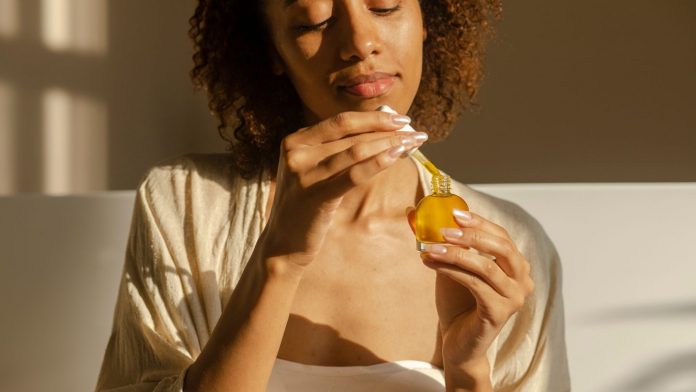It can do everything it needs to do by itself.
My skin wants for nothing. It is lavished daily with all the buzziest beauty ingredients: ceramides and peptides, antioxidants and antimicrobials. Exfoliating enzymes, epidermal growth factor, stem cells, and squalene oil. Pre-, pro-, and post-biotics, plus a pore-clearing cleanser that balances my pH level. Collagen, of course, and hydrating humectants: glycerin, hyaluronic acid, lactic acid. Finally, a face oil—one that’s biocompatible and full of essential fatty acids.
You may scan that list and think: in this economy? But let me assure you, no plastic bottles were squeezed in the making of this skin care routine. I haven’t used an essence or eye cream in years. I don’t need to. You don’t need to. The human body produces all the aforementioned chemicals on its own. It uses them to self-moisturize, self-exfoliate, self-protect, self-heal, and even self-cleanse.
My skin wants for nothing. It is lavished daily with all the buzziest beauty ingredients: ceramides and peptides, antioxidants and antimicrobials. Exfoliating enzymes, epidermal growth factor, stem cells, and squalene oil. Pre-, pro-, and post-biotics, plus a pore-clearing cleanser that balances my pH level. Collagen, of course, and hydrating humectants: glycerin, hyaluronic acid, lactic acid. Finally, a face oil—one that’s biocompatible and full of essential fatty acids.
You may scan that list and think: in this economy? But let me assure you, no plastic bottles were squeezed in the making of this skin care routine. I haven’t used an essence or eye cream in years. I don’t need to. You don’t need to. The human body produces all the aforementioned chemicals on its own. It uses them to self-moisturize, self-exfoliate, self-protect, self-heal, and even self-cleanse.
Where do you think beauty brands get their big ideas, anyway?
The notion that skin care products are largely unnecessary isn’t new. “Commercials tell us to remove the oil from our skin with soap, and then to moisturize with lotion,” wrote physician and public health expert James Hamblin in a 2016 article for the Atlantic on how he quit showering “Evolutionarily, why would we be so disgusting that we need constant cleaning? And constant moisturizing and/or de-oiling?”
“[S]kin has withstood millions of years of evolution without the aid of tinctures and balms,” agreed Krithika Varagur in a 2018 piece for the Outline, arguing that pummeling your face with ingredients is “violence” and “perfect skin” is unattainable anyway.
Even dermatologists concur. “Most skin-care products are kind of a scam,” said Jules Lipoff, an assistant professor of dermatology at the University of Pennsylvania Perelman School of Medicine, in a 2019 article for the Philadelphia Inquirer. “The beauty industry plays upon our insecurities, superstitions, and our tendency to enjoy the complicated.”
Despite what marketing campaigns may say, your routine need not involve multiple bottles of various actives—or even a single fancy cleanser. You can count on your own body to produce most of what your skin needs by itself. Not convinced? Let’s go on a little tour through some of the important things it can do without assistance—the skin care that your skin, and mine, gets every single day without intervention.
The Skin Moisturizes Itself
Don’t call it grime. That light layer of “oiliness” on your skin is actually sebum, which “helps seal in moisture and prevent the skin from becoming dry,” Devika Icecreamwala, a board-certified dermatologist in California, tells Slate. The much-maligned substance—technically a “wax ester”—contains nourishing lipids, fatty acids, cholesterol, glycerol, and squalene and is continuously excreted through the pores (the original refillable packaging). On the surface, sebaceous fluids mingle with omega-3 and omega-6 essential fatty acids, vitamin E, and your very own ceramides to form the skin barrier, also known as the stratum corneum. This layer slows the evaporation of cells’ hydration.
Most of that hydration exists within the skin—water-loving hyaluronic acid molecules, for example, live in the deeper portion of the dermis—though a small percentage is absorbed from the environment. Water meets oil and voilà: moisturizer. The skin obtains this external hydration via its own natural moisturizing factors, or NMFs. “The components that make up NMF are excellent humectants,” says Ranella Hirsch, a board-certified dermatologist and founder of Atolla Custom Skincare. You’ll recognize them from the labels of your beloved beauty products: glycerin, lactic acid, amino acids, urea, and sodium pyrrolidone carboxylic acid.
These chemicals promote hydration by “attracting water into the corneocytes,” Hirsch explains— “corneocyte” being the scientific term for “dead skin cell.” Yes, that means your skin needs “dead” skin cells in order to function—and that your favorite exfoliant, by sloughing them off, may be making it harder for your skin to stay moisturized. (Keratinocytes, the supposedly “fresh, smooth” cells that sit underneath the “dead” ones, aren’t the right shape and size to store NMFs.)
My skin wants for nothing. It is lavished daily with all the buzziest beauty ingredients: ceramides and peptides, antioxidants and antimicrobials. Exfoliating enzymes, epidermal growth factor, stem cells, and squalene oil. Pre-, pro-, and post-biotics, plus a pore-clearing cleanser that balances my pH level. Collagen, of course, and hydrating humectants: glycerin, hyaluronic acid, lactic acid. Finally, a face oil—one that’s biocompatible and full of essential fatty acids.
You may scan that list and think: in this economy? But let me assure you, no plastic bottles were squeezed in the making of this skin care routine. I haven’t used an essence or eye cream in years. I don’t need to. You don’t need to. The human body produces all the aforementioned chemicals on its own. It uses them to self-moisturize, self-exfoliate, self-protect, self-heal, and even self-cleanse.
Where do you think beauty brands get their big ideas, anyway?
The notion that skin care products are largely unnecessary isn’t new. “Commercials tell us to remove the oil from our skin with soap, and then to moisturize with lotion,” wrote physician and public health expert James Hamblin in a 2016 article for the Atlantic on how he quit showering “Evolutionarily, why would we be so disgusting that we need constant cleaning? And constant moisturizing and/or de-oiling?”
“Skin has withstood millions of years of evolution without the aid of tinctures and balms,” agreed Krithika Varagur in a 2018 piece for the Outline, arguing that pummeling your face with ingredients is “violence” and “perfect skin” is unattainable anyway.
Even dermatologists concur. “Most skin-care products are kind of a scam,” said Jules Lipoff, an assistant professor of dermatology at the University of Pennsylvania Perelman School of Medicine, in a 2019 article for the Philadelphia Inquirer. “The beauty industry plays upon our insecurities, superstitions, and our tendency to enjoy the complicated.”
Despite what marketing campaigns may say, your routine need not involve multiple bottles of various actives—or even a single fancy cleanser. You can count on your own body to produce most of what your skin needs by itself. Not convinced? Let’s go on a little tour through some of the important things it can do without assistance—the skin care that your skin, and mine, gets every single day without intervention.
The Skin Moisturizes Itself
Don’t call it grime. That light layer of “oiliness” on your skin is actually sebum, which “helps seal in moisture and prevent the skin from becoming dry,” Devika Icecreamwala, a board-certified dermatologist in California, tells Slate. The much-maligned substance—technically a “wax ester”—contains nourishing lipids, fatty acids, cholesterol, glycerol, and squalene and is continuously excreted through the pores (the original refillable packaging). On the surface, sebaceous fluids mingle with omega-3 and omega-6 essential fatty acids, vitamin E, and your very own ceramides to form the skin barrier, also known as the stratum corneum. This layer slows the evaporation of cells’ hydration.
Most of that hydration exists within the skin—water-loving hyaluronic acid molecules, for example, live in the deeper portion of the dermis—though a small percentage is absorbed from the environment. Water meets oil and voilà: moisturizer. The skin obtains this external hydration via its own natural moisturizing factors, or NMFs. “The components that make up NMF are excellent humectants,” says Ranella Hirsch, a board-certified dermatologist and founder of Atolla Custom Skincare. You’ll recognize them from the labels of your beloved beauty products: glycerin, lactic acid, amino acids, urea, and sodium pyrrolidone carboxylic acid.
These chemicals promote hydration by “attracting water into the corneocytes,” Hirsch explains— “corneocyte” being the scientific term for “dead skin cell.” Yes, that means your skin needs “dead” skin cells in order to function—and that your favorite exfoliant, by sloughing them off, may be making it harder for your skin to stay moisturized. (Keratinocytes, the supposedly “fresh, smooth” cells that sit underneath the “dead” ones, aren’t the right shape and size to store NMFs.)
The Skin Exfoliates Itself
Don’t worry, your skin doesn’t just endlessly pile up with “dead” cells. Once corneocytes have fulfilled their purpose, the skin self-exfoliates through a “natural shedding function called desquamation,” says board-certified dermatologist Joshua Zeichner. It takes the average skin cell 28 days to cycle from creation to desquamation. That process is activated by bodily enzymes that loosen the bonds between corneocytes and the barrier.
Your microbiome—the symbiotic collection of 1 trillion bacteria, fungi, viruses, and other microorganisms living on and in your skin—offers another form of very natural self-exfoliation. Certain microbes “are voraciously eating up as much dead skin as possible,” writes dermatologist Monty Lyman in The Remarkable Life of the Skin. Corneocytes, then, can be considered innate prebiotics (substances that nourish bacteria), since they feed your innate probiotics (live, microbiome-dwelling bacteria), which in turn produce postbiotics (beneficial materials secreted by said live bacteria, like ceramides and antimicrobial peptides). Sebum is also an innate prebiotic, by the way. Microbes slurp it up, thereby balancing your oil levels.
The Skin Protects Itself
By nature, the skin is vulnerable to outside aggressors like pathogens, pollution, and sunlight. Not to worry: It has self-protection down to a science thanks to the surface’s acid mantle. Thought to be a byproduct of the microbiome, the acid mantle is “composed of natural oils and amino acids, which create a protective film to cover the skin,” says Icecreamwala. Sweat contributes to the acid mantle as well, helping it maintain a pH of around 4.4—the ideal level for neutralizing opportunistic bacteria, viruses, and more.
Lipids on the skin’s surface work to mitigate the effects of pollution, too. Antioxidant vitamin E and omega-3 fatty acids decrease the oxidative stress caused by free radicals. Additionally, studies show that P. acnes—commonly and unfairly known as the “acne-causing bacteria”—produce antioxidant proteins that protect from free radical damage.
The Skin Heals Itself
“The skin is an amazing organ that repairs itself from trauma,” says Zeichner. When wounded—whether in the form of a scrape or cut, sunburn, free radical exposure, or an infected blemish—the skin kick-starts a complex healing process that “recruits” certain cells to care for the injured area, Icecreamwala elaborates. “One type of these cells is fibroblasts, which produce collagen and elastin to replace the damaged skin.” In the case of sun damage, the skin sends enzymes and proteins to compromised cells to initiate DNA repair. The skin barrier has inherent photoprotective properties as well, which can help shield against the sun in the first place. (Do help your skin out with sunscreen though—that’s one traditional product dermatologists say you should definitely use.)
The Skin Even Cleanses Itsel
Your lymphatic system is continuously ridding skin cells of waste products and toxins. You’re naturally equipped with pore-clearing cleansers, too: sweat and sebum. These substances “wash” the pores as they pour through, pushing out buildup and neutralizing opportunistic bacteria. Like almost every other creature on Earth, you’ll want to rinse off sometimes. Water works just fine.
Messing With the Skin Can Upset It
“Today we have never used so many products and yet, our skin has never been worse,” says Elsa Jungman, a skin pharmacologist and microbiome expert. “The more ingredients we use, the more it can damage our skin barrier and microbiome, and the more we remove the essential nutrients [it needs] to function properly”—aka, all those inherent cosmetic chemicals. This can lead to flare-ups of inflammatory conditions like acne, rosacea, eczema, and psoriasis, which leads to the use of more products to fix the problems caused by the first products, over and over again.
That said, sometimes your skin needs support (or your brain needs a fun spa day). A few choice products can be fine. In general, these should facilitate your skin’s own functions rather than wrestle them into smooth and shiny submission. My personal routine consists of cleansing with manuka honey, a prebiotic that feeds the microbiome, and applying mineral SPF to protect my skin from sun damage. When I need to remove sunscreen or makeup, I reach for plain jojoba oil, since it’s a close chemical match to human sebum. Jojoba makes an excellent moisturizer when applied to damp skin, too, so I’ll use some when my face feels particularly dry. Your routine may be different based on your body’s unique needs and any medical issues you might need to address. (And by all means, please get your moles checked.)
Giving up (most of) your skin care can seem scary, but it doesn’t mean giving up “good skin.” After a 28-day cycle sans products, your microbiome will repopulate, your skin’s inherent functions will reregulate, and you’ll likely find you never needed 10 steps, or five, or even two. Self-sufficient amalgam of oil and water and squalene and ceramides that it is, the skin can’t help but glow





























